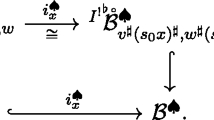Abstract
Let \(V\) be a symplectic vector space of dimension \(2n\). Given a partition \(\lambda \) with at most \(n\) parts, there is an associated irreducible representation \(\mathbf{{S}}_{[\lambda ]}(V)\) of \(\mathbf{{Sp}}(V)\). This representation admits a resolution by a natural complex \(L^{\lambda }_{\bullet }\), which we call the Littlewood complex, whose terms are restrictions of representations of \(\mathbf{{GL}}(V)\). When \(\lambda \) has more than \(n\) parts, the representation \(\mathbf{{S}}_{[\lambda ]}(V)\) is not defined, but the Littlewood complex \(L^{\lambda }_{\bullet }\) still makes sense. The purpose of this paper is to compute its homology. We find that either \(L^{\lambda }_{\bullet }\) is acyclic or it has a unique nonzero homology group, which forms an irreducible representation of \(\mathbf{{Sp}}(V)\). The nonzero homology group, if it exists, can be computed by a rule reminiscent of that occurring in the Borel–Weil–Bott theorem. This result can be interpreted as the computation of the “derived specialization” of irreducible representations of \(\mathbf{{Sp}}(\infty )\) and as such categorifies earlier results of Koike–Terada on universal character rings. We prove analogous results for orthogonal and general linear groups. Along the way, we will see two topics from commutative algebra: the minimal free resolutions of determinantal ideals and Koszul homology.
Similar content being viewed by others
Notes
Technically, we should use the “pro” version of the category, which is opposite to the more usual “ind” version of the category. See [17] for details.
References
Avramov, L., Herzog, J.: The Koszul algebra of a codimension 2 embedding. Math. Z. 175(3), 249–260 (1980)
Brylinski, R.K.: Matrix concomitants with the mixed tensor model. Adv. Math. 100(1), 28–52 (1993)
Dan-Cohen, E., Penkov, I., Serganova, V.: A Koszul category of representations of finitary Lie algebras. arXiv:1105.3407v2
Enright, T.J., Willenbring, J.F.: Hilbert series, Howe duality and branching for classical groups. Ann. Math. (2) 159(1), 337–375 (2004)
Fulton, W., Harris, J.: Representation Theory: A First Course, Graduate Texts in Mathematics 129. Springer, New York (1991)
Howe, R.: Perspectives on invariant theory: Schur duality, multiplicity-free actions and beyond. In: Israel Mathematical Conference Proceedings, vol. 8 (1995)
Howe, R., Tan, E.C., Willenbring, J.F.: Stable branching rules for classical symmetric pairs. Trans. Am. Math. Soc. 357(4), 1601–1626 (2005). arXiv:math/0311159v2
Humphreys, J.E.: Reflection Groups and Coxeter Groups. Cambridge Studies in Advanced Mathematics 29. Cambridge University Press, Cambridge (1990)
Józefiak, T., Pragacz, P., Weyman, J.: Resolutions of determinantal varieties and tensor complexes associated with symmetric and antisymmetric matrices, Young tableaux and Schur functors in algebra and geometry (Toruń, 1980), pp. 109–189, Astérisque, vol. 87–88, Soc. Math. France, Paris (1981)
King, R.C.: Modification rules and products of irreducible representations of the unitary, orthogonal, and symplectic groups. J. Math. Phys. 12, 1588–1598 (1971)
Koike, K.: On the decomposition of tensor products of the representations of the classical groups: by means of the universal characters. Adv. Math. 74(1), 57–86 (1989)
Koike, K., Terada, I.: Young-diagrammatic methods for the representation theory of the classical groups of type \(B_n, C_n\), \(D_n\). J. Algebra 107(2), 466–511 (1987)
Lascoux, A.: Syzygies des variétés déterminantales. Adv. Math. 30(3), 202–237 (1978)
Littlewood, D.E.: The Theory of Group Characters and Matrix Representations of Groups, Reprint of the 2nd edn (1950). AMS Chelsea Publishing, Providence, RI (2006)
Macdonald, I.G.: Symmetric Functions and Hall Polynomials, 2nd edn. Oxford Mathematical Monographs, Oxford (1995)
Sam, S.V., Snowden, A.: GL-equivariant modules over polynomial rings in infinitely many variables. arXiv:1206.2233v1
Sam, S.V., Snowden, A.: Stability patterns in representation theory (in preparation)
Sam, S.V., Weyman, J.: Koszul homology of codimension 3 Gorenstein ideals. Proc. Am. Math. Soc. (to appear). arXiv:1203.3168v1
Sundaram, S.: Tableaux in the representation theory of the classical Lie groups, Invariant theory and tableaux (Minneapolis, MN, 1988), pp. 191–225, IMA Vol. Math. Appl. vol. 19. Springer, New York (1990)
Wenzl, H.: Quotients of representation rings, Represent. Theory 15 (2011), 385–406, arXiv: 1101.5887v1
Weyman, J.: Cohomology of Vector Bundles and Syzygies. Cambridge University Press, Cambridge (2003)
Author information
Authors and Affiliations
Corresponding author
Additional information
S. Sam was supported by an NDSEG fellowship and a Miller research fellowship.
A. Snowden was partially supported by NSF fellowship DMS-0902661.
J. Weyman was partially supported by NSF grant DMS-0901185.



